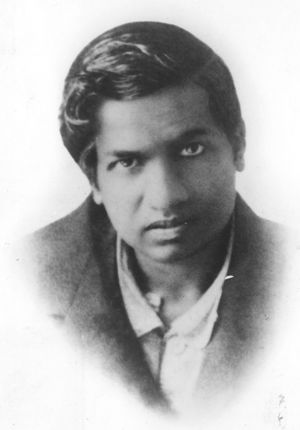Srinivasa Ramanujan, FRS ஸ்ரீநிவாச ராமானுஜன்
1887-1920. Mathematician. 
Srinivasa Ramanujan was an autodidact who, with almost no formal training in pure mathematics, made extraordinary contributions to mathematical analysis, number theory, infinite series and continued fractions. G.H. Hardy called him a natural genius.
Born into a poor Brahmin family in India, Ramanujan's introduction to formal mathematics began at the age of ten. He demonstrated a natural ability, and was given books on advanced trigonometry which he mastered by the age of twelve; he even discovered theorems of his own, and re-discovered Euler's identity independently. He demonstrated unusual mathematical skill at school, winning accolades and awards. By the age of seventeen Ramanujan had conducted his own mathematical research on Bernoulli numbers and the Euler-Mascheroni constant.
Ramanujan received a scholarship to study at Government College in Kumbakonam, but lost it when he failed his non-mathematical coursework. He joined another college to pursue independent mathematical research, working as a clerk in the Accountant-General's office at the Madras Port Trust Office to support himself. In 1912-1913 he sent samples of his theorems to three academics at the University of Cambridge. G.H. Hardy, recognizing the brilliance of his work, invited Ramanujan to visit and work with him at Cambridge. He became a FRS and a Fellow of Trinity. He died of illness, malnutrition, and possibly liver infection, in 1920 (after leaving Cambridge), at the age of 32.
During his short lifetime, Ramanujan independently compiled nearly 3900 results (mostly identities and equations). Most of his claims have now been proven correct, although a small number of these results were actually false and some were already known. He stated results that were both original and highly unconventional, such as the Ramanujan prime and the Ramanujan theta function, and these have inspired a vast amount of further research. The Ramanujan Journal, an international publication, was launched to publish work in all areas of mathematics influenced by his work.
In December 2011, in recognition of his contribution to mathematics, the Government of India declared that Ramanujan's birthday (22 December) should be celebrated every year as National Mathematics Day, and also declared 2012 the National Mathematical Year.
| Memorial inscription | Translation |
|
SRINIVASA RAMANUJAN MVLTA ET MIRANDA DE NVMERIS REPPERIT |
Srinivasa Ramanujan discovered many extraordinary facts in Number Theory. G.H. Hardy recognised his exceptional talent, brought him to England, and encouraged his work. Ramanujan was the first Indian to be elected a Fellow of the Royal Society; later he was made a Fellow of the College. After a long illness he returned to India for the sake of his health and died at an early age in 1920. |
Srinivasa RamanujanBrass located on the north wall of the Ante-Chapel. |
|
|
|
PREVIOUS BRASS |
|
NEXT BRASS Robert Mantle Rattenbury |
| Brasses A-B | Brasses C-G | Brasses H-K | Brasses L-P | Brasses R-S | Brasses T-W |

